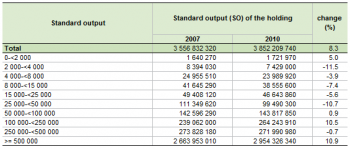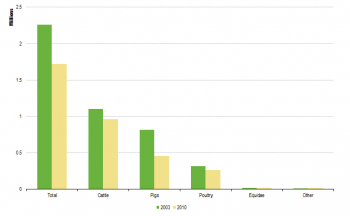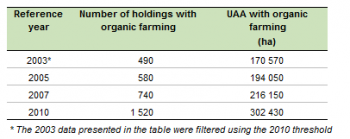Archive:Agricultural census in Norway
- Data from November 2012. Most recent data: Further Eurostat information, Main tables and Database.
This article is part of a series of country-specific essays on the results of the European Union (EU) Farm structure survey (FSS) 2010. The FSS collects information on the structural characteristics of the agricultural holdings (land use, livestock and labour force) and is carried out by all European Union Member States every 10 years as an Agricultural census, with two or three additional, intermediate sample surveys carried out in-between. The Agricultural census 2010 was the first one to be fully harmonised with the EU regulation in the Czech Republic, although most of the indicators included in the previous Agricultural census (2000) were in line with the EU requirements.
The present analysis of the farm structure includes a comparison with the FSS 2003, the first one to be carried out according to the EU requirements in the Czech Republic.
The FSS 2003 and the Agricultural census 2010 were carried out using two very different thresholds[1]: all farms with more than one hectare of agricultural land were surveyed in 2003, whereas only holdings with more than 5 hectares of agricultural area were included in the FSS 2010. To overcome this methodological issue and to draft the present article, the 2003 values were filtered using the 2010 threshold. Accordingly, the FSS 2003 figures mentioned throughout this article and presented in the tables exhibited, or available through hyperlinks, differ from the ones presented in the Eurostat online database. Nonetheless, to be thorough, hyperlinks to the online database were also provided throughout the article.

Source: Eurostat (ef_kvaareg) (ef_ov_kvaa) (demo_pjan) and FSS 2003 and 2010
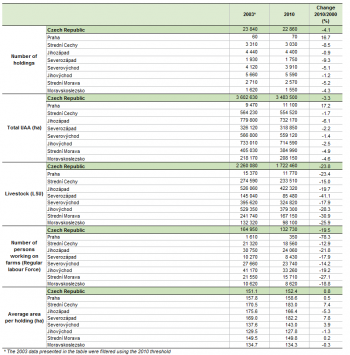
Source: Eurostat (ef_kvaareg) (ef_ov_kvaa) and FSS 2003 and 2010
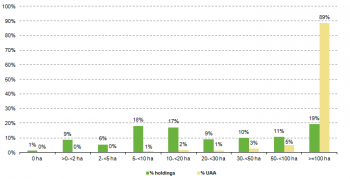
Source: Eurostat (ef_kvaareg) (ef_ov_kvaa)

Source: Eurostat (ef_kvftreg)
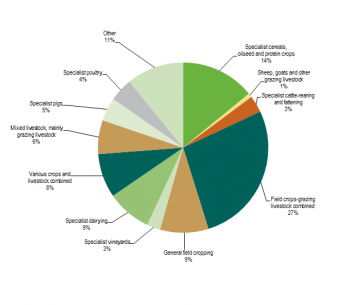
Source: Eurostat (ef_kvftreg)
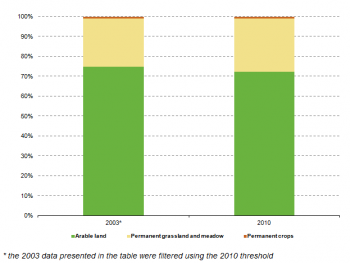
Source: Eurostat (ef_lu_ovcropaa) (ef_oluaareg)
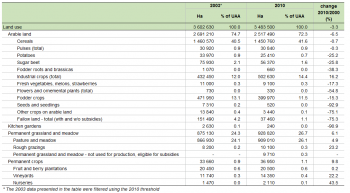
Source: Eurostat (ef_lu_ovcropaa) (ef_oluaareg)

Source: Eurostat (ef_mptenure)

Source: Source: Eurostat (ef_pmhouscatlaa)
Main statistical findings
Key indicators
According to the Agricultural census 2010, there were 22 860 agricultural holdings in the Czech Republic (see Table 1), a figure which places the country among those with the smallest number of farms within the EU-27. If the 2010 threshold is used to filter data from the FSS 2003, not much appears to have changed since 2003 as there were 23 840 agricultural holdings in the Czech Republic that year: a 4 % drop compared to 2010, which accounts for about 1 000 farms.
Also the utilised agricultural area (UAA) remained quite stable over the 2003-2010 timeframe, dropping by only about 120 000 hectares (-3 %). Accordingly, in 2010 there were almost 3.5 million hectares of UAA in the Czech Republic, corresponding to 44 % of the whole country.
In 2010, a rather limited number of farms covered a wide agricultural area in the Czech Republic. As a result, the average area per holding in this country represented the highest value within the EU 27: 152 hectares per farm, a figure about two times bigger than the second highest one recorded among the EU Member States (84 hectares per holding registered in the UK). Furthermore, as both the UAA and the number of holdings did not change much over the 2003-2010 timeframe, this feature could be considered as a long-term structural characteristic of the Czech agriculture.
Although the number of agricultural holdings did not change much within the period under analysis, the number of persons regularly working in agriculture dropped by about 20 %, following a similar tendency already observed in most of the EU Member States. The figures for agricultural employment in the Czech Republic fell from about 165 000 in 2003 to roughly 133 000 in 2010, which indicates a loss of more than 32 000 jobs. Consequently, in 2010 the agricultural labour force represented 2.6 % of the Czech active population[2].
If the livestock population – expressed in livestock units (LSU) – is taken into account, an even higher decrease is observed: whereas 2.3 million LSU were recorded in 2003 in the Czech Republic, there were only 1.7 million of them in 2010 (-24 %), which pertains to a loss of 538 000 units. Accordingly, although the Czech Republic was not among the EU Member States with the highest numbers of LSU, its figure remained above the one million threshold in 2010.
Regional key indicators
The regional data exhibited in Table 2 provide an insight into the local characteristics of the Czech agriculture and highlight the leading role played by three regions, namely the territories of Jihozápad, Jihovýchod and Severovýchod. Indeed, for each of the indicators analysed (number of holdings, total UAA, livestock population and number of persons working on the farms) those three territories scored the highest values and together accounted for over half of the country’s total values.
In terms of the number of holdings, the territory of Jihovýchod proved to be the most important as 5 590 farms were registered within its borders in 2010 – which represented 24 % of the total population of agricultural holdings. The second most important region was found to be Jihozápad – where 4 400 farms were surveyed, accounting for 19 % of the total population – while Severovýchod recorded the third highest number of farms (3 910), corresponding to 17 % of the total population. On the other hand, the capital region of Praha proved to have a marginal share (0.3 %), as only 70 farms were surveyed within its territory in 2010; the number was 60 in 2003.
The rank of the regions looks similar if the UAA is taken in to account. In this case it was the territory of Jihozápad which proved to be the most important one, as 21 % of the Czech UAA was surveyed within its borders (732 170 ha) in 2010. The percentage of agricultural area recorded in Jihovýchod was slightly smaller (20 %) and accounted for 714 590 hectares. Severovýchod recorded the third highest value: 559 120 hectares, corresponding to 16 % of the UAA of the whole country. On the other end of the scale, the capital region of Praha again proved to be the least significant, accounting for only 0.3 % of the Czech UAA (11 100 ha).
The three regions of Jihozápad, Jihovýchod and Severovýchod together accounted for 65 % of the Czech livestock population in 2010 – a very similar percentage was recorded in 2003 (64 %). In particular, the highest number of livestock was recorded in Jihozápad (422 320 LSU) and accounted for 24 % of the total livestock population. The region of Jihovýchod accounted for 22 %, i.e. 379 300 LSU, while 324 820 LSU were recorded in Severovýchod (19 %). On the other hand, the smallest number of LSU was observed in Praha: 11 770 LSU, corresponding to 0.7 % of the Czech livestock population in 2010.
With reference to the average area of the agricultural holding, half of all the Czech regions (i.e. the territory of Severovýchod, Jihovýchod, Strední Morava and Moravskoslezsko) recorded values below the average of 152.4 hectares. On the other hand, the regions of Praha, Strední Cechy, Jihozápad and Severozápad were above the average, with the region of Strední Cechy recording the highest value: 183 hectares per holding.
Agricultural holdings
The analysis of the farm structure by size class, exhibited in figure 1, highlights the peculiar nature of the Czech agriculture. According to the FSS 2010 data, the vast majority of the UAA (89 %) belonged to a very small number of big farms (19 %) in the Czech Republic, those with 100 hectares or more of agricultural land. In absolute terms, this means that about 3.1 million hectares of agricultural land were found to belong to 4 420 farms in 2010.
On the other hand, most of the Czech farms (81 %) shared a very low percentage of agricultural land (11 %): indeed, 18 450 agricultural holdings accounted for only 398 330 hectares of agricultural land in 2010.
This awkward distribution, for which many small holdings share a low percentage of agricultural land while a few big farms own the vast majority of the UAA, justifies the unusually high average area per holding registered in the Czech Republic in 2010 (152 hectares per farm).
See detailed data at NUTS 2 level for 2010 and 2000
Economic size of the farm
In 2010, the economic size of all the Czech agricultural holdings was EUR 3 852 million (see Table 3). This value, calculated by adding all the standard output (SO) per hectare of crop and per head of livestock of the farms, proved to be more than two times bigger than the one recorded for the neighbouring country Slovakia (EUR 1 731 million). Compared to the FSS 2007 value (EUR 3 557 million), an increase of 8.3 %, mainly attributable to the biggest class of holdings, was registered. Also in economic terms, the structure of the Czech agriculture appeared skewed, with one class of farms – those with EUR 500 000 or more of SO – accounting for about 77 % of the total economic value of the Czech holdings; their share was of 75 % in 2003. On the other hand, all the other classes of farms together accounted for 23 % of the economic size of the agricultural holdings population – the corresponding share in 2007 was 25 %.
Among the Czech regions, the territory of Jihovychod proved to be the most important one in terms of the economic size. It accounted for the 25 % of the SO of the whole country and recorded a value of EUR 981 201 220 in 2010. The second highest SO was reported for Jihozapad – EUR 726 340 300, corresponding to 19 % – whereas the third highest figure, EUR 646 596 150, was recorded in Stredni Cechy and accounted for 17 % in 2010.
See detailed data at NUTS 2 level for 2010 and 2007
Agricultural holding by main type of farming
According to the FSS 2010, agricultural holdings specialised in the production of cereals, oilseed and protein crops were the most common in the Czech Republic: they represented 20 % of the total population of farms. The second most common type of holding – in terms of the main type of farming – was the sheep, goats and other grazing livestock farm, which accounted for 15 %, a share slightly higher than the one recorded by holdings specialised in cattle-rearing and fattening (13 %). Farms dedicated to the production of field crops-grazing livestock combined (12 %) and those specialised in general field cropping (11 %) were the only other ones recording double digit shares, with farms specialised in vineyards (8 %) falling right below that threshold.
In terms of the economic size, the ranking appears different and suggests the existence of two main types of productions, which together accounted for 41 % of the total SO of the Czech agricultural holdings. Indeed, agricultural holdings dedicated to field crops-grazing livestock combined represented 27 % of the SO of all the Czech farms, while agricultural holdings specialised in cereals, oilseed and protein crops recorded 14 % in 2010. Holdings specialised in any other type of production registered shares of less than 10 %.
See detailed data at NUTS 2 level for 2010
Land use
The Utilised Agricultural Area (UAA) is the total area used by the holding, regardless of the type of tenure or whether it is used as a part of common land; it is taken up by arable land, permanent grassland and meadow, permanent crops and kitchen gardens. In the Czech Republic, both the UAA and the share of its main components – arable land and permanent grassland and meadows – remained fairly stable over the 2003-2010 period (see Table 4).
According to the Agricultural census 2010, arable land in the Czech Republic accounted for 72.3 % of the total UAA, while permanent grassland and meadow shared 26.7 % (permanent crops accounted for a marginal 1.1 %). Accordingly, arable land and permanent grassland and meadow together accounted for 99 % of the whole UAA – the very same percentage they recorded in 2003.
See detailed data at NUTS 2 level for 2010 and 2000
Arable land
In the Czech Republic, arable land was essentially taken up by cereals, industrial crops and fodder crops and remained relatively stable over the 2003-2010 timeframe, dropping only by 6.5 %. In particular, cereals represented by far the main type of production as 1.4 million hectares – 41.6 % of the entire UAA – were dedicated to this kind of harvest in 2010. Industrial crops recorded the second highest share in terms of UAA (14.4 %), corresponding to 502 630 hectares, whereas fodder crops recorded a slightly lower share of agricultural area (11.5 %) and accounted for 399 970 hectares.
See detailed data at NUTS 2 level for 2010 and 2000
Permanent grassland and meadow
In the Czech Republic, the area of permanent grassland and meadow increased by 6.1 % within the timeframe under analysis, reaching 928 820 hectares in 2010. Nonetheless, its composition did not change over the years: the land dedicated to pasture and meadow represented the vast majority of permanent grassland and meadow in both reference years: 866 930 ha accounting for 24.3 % of UAA in 2003 and 909 010 ha corresponding to 26.1 % in 2010. Consequently, the share of land dedicated to rough grazing remained marginal, covering only 10 100 hectares in 2010 (compared to 8 200 hectares in 2003).
See detailed data at NUTS 2 level for 2010 and 2000
Livestock
Statistics on livestock use two different units of measurement: the number of heads (number of animals) and the livestock units (LSU), with the latter allowing comparison between different types.
In 2010, 1.7 million LSU were recorded in the Czech Republic (see Table 5) – they were 2.3 million in 2003 (-24 %). Although this did not constitute the highest values surveyed within the EU-27, it was more than two times bigger than the figure recorded in the neighbouring Slovakia (668 340 LSU). In relative terms, there were 0.33 LSU per inhabitant in 2010, a value which indicates a decrease compared to the 2003 figure (0.35). Indeed, between 2003 and 2010 the Czech population increased by 3 % while the livestock decreased by about 24 %.
In 2010, cattle were by far the most important livestock in the Czech Republic. They represented about 56 % of the livestock population and indicated the value of 960 810 LSU, having recorded a 13 % decrease compared to 2003. As exhibited in Table 5, pigs were the second most important type of livestock and accounted for 26 % of farm animals. Although their number halved over the period under analysis, dropping by about 360 000 LSU, they indicated the value of 457 210 LSU in 2010. Furthermore, poultry recorded a value worth mentioning (264 100 LSU), as it accounted for 15 % of Czech livestock in 2010. Nonetheless, it had fallen by 16 % within the 2003-2010 timeframe, with a loss of about 50 000 LSU.
As the number of farm animals dropped (-24 %), so did the number of holdings with livestock. In particular, while there were 18 560 farms with livestock in 2003, only 15 920 were left in 2010 (-14 %). Moreover, since the number of farms remained fairly stable between 2003 and 2010 (merely decreasing by 4 %) and the population of farms with livestock dropped, the share of the number of holdings with livestock over the total number of holdings fell from 78 % in 2003 to 70 % in 2010. In particular, values largely decreased for farms with 1 to 4 LSU (-25 %) and for those with 500 or more LSU (-24 %).
Accounting for about one fourth of the whole population of livestock, the region of Jihozapad was the territory hosting the highest number of LSU in 2010 (422 320). Furthermore, this proved to be the territory with the highest number of farms with livestock: 3 750, corresponding to 24 % of the total population of holdings with livestock.
In terms of holdings with LSU, Severovychod proved to be the second most important region, as 20 % of all the farms with livestock were registered within its territory (3 130). Moreover, 19 % of the Czech livestock population – 324 820 LSU – was hosted within its borders in 2010. If the number of farm animals is taken into account, it was Jihovychod that scored the second highest values in the Czech Republic: 379 300 LSU, accounting for 22 % of the livestock population. Jihovychod also recorded the third highest figure in terms of holdings with livestock: 17 %, corresponding to 2 780 LSU.
See detailed data at Nuts 2 level for 2010 and 2003
Labour force
In the Czech Republic, 132 730 persons were working in agricultural holdings in 2010 (see Table 6), a value which was found to be among the lowest surveyed within the EU-27 and which represented a 19.5 % drop compared to 2003. In terms of the annual work unit (AWU), if the direct labour force is taken into account, the Czech Republic recorded a value roughly two times higher (107 990 AWU) than the one recorded for the neighbouring country Slovakia.
In 2010, the territory of Jihovychod recorded the highest number of persons employed on a regular basis: 33 260, corresponding to 25 % of the Czech regular agricultural labour force. The territory of Severovychod and Jihozapad registered very similar values – 23 740 persons in the former case, 24 060 for the latter one – and both accounted for 18 % of the regular agricultural labour force in 2010.
In terms of sole holders, the gender distinction appeared to be quite substantial as more than 4 out of 5 sole holders proved to be male in 2010. Moreover, this tendency seemed to be stable as figures did not change over the period under analysis.
See detailed data at NUTS 2 level on holders' age and gender for 2010 and 2003
See detailed data at NUTS 2 level on type of labour force for 2010 and 2003
Management practices
Type of tenure
Whereas in most of the EU Member State the majority of the UAA is owned by the farmers, in the Czech Republic the agricultural area is generally rented by the persons who work on it. Indeed, according to the Agricultural census 2010, only 22 % of the Czech UAA belonged to the farmers who actually worked on that land (see Table 7). Within this context the region of Severozápad stands out as 39 % of its agricultural area was found to belong to the farmers who actually worked on it. Relatively high percentages of owned land were also observed in Moravskoslezsko (27.1 %) and Jihozápad (23.3 %).
On the other hand, the area farmed by tenants summed up to 78 % of the total UAA. Remarkably high values were found in the capital region of Praha (88.6 %), Strední Morava (84.7 %) and Jihovýchod (81.8 %).
In the Czech Republic, the share-farmed agricultural area – which is an agricultural area utilised in partnership by the landlord and the sharecropper under a written or oral share-farming contract, or it is an area utilised under other modes of tenure – is a non-significant characteristic, thus it was not surveyed.
Animal housing
In 2010, the Czech Republic was among the EU Member States with the lowest numbers of holdings with cattle. According to the FSS 2010, there were 10 080 farms raising 1.3 million heads of cattle for a total of about 1.4 million places. Hence, in the Czech Republic the number of places slightly exceeded the number of heads of cattle, explaining why that percentage was more than 100.
The type of housing where animals are allowed to move freely with solid dung and liquid manure was by far the most common one in 2010 (see Table 9): it accounted for 1 045 660 places and was recorded in 4 870 holdings. The second most frequent type of housing for cattle proved to be the one where animals are in stanchion tied with solid dung and manure: in this case, 144 630 places were registered in 4 980 different holdings.
Other gainful activities
In 2010, there were 3 440 holdings with other gainful activities in the Czech Republic. These farms, which represented 15 % of the total population of agricultural holdings, recorded activities other than farm work, directly related to the holding and having an economic impact on the farm. In absolute terms, their number was found to be among the lowest within the EU-27. On the contrary, their share over the total number of holdings proved to be among the highest among the EU Member State.
Information on other gainful activities was collected by eleven category types depending on their characteristics – one holding could register more than one activity.
In 2010, a high number of holdings with other gainful activities were surveyed in both Severovýchod and Strední Cechy. Indeed, 630 farms with activities other than agriculture were recorded in Severovýchod and 580 in Strední Cechy.
In the Czech Republic , as in many of the EU Member States, the most common type of other gainful activities was found to be contractual work (1 980 holdings), which mainly consisted of contractual agricultural work (1 390 holdings).
See detailed data at NUTS 2 level for 2003
Organic farming
Organic agriculture is an ecological production management system that promotes and enhances biodiversity, biological cycles, and soil biological activity. It is based on the minimal use of off-farm inputs and on the management practices that restore, maintain or enhance ecological harmony.
Within the 2003-2010 timeframe, the UAA under organic farming increased steadily in the Czech Republic, covering 8.7 % of the total agricultural area in 2010. As showed in Table 12, in absolute terms, it grew from 170 570 hectares in 2003 to 302 430 in 2010.
See detailed data at Nuts 2 level for 2010, 2007, 2005,2003 and 2000
Data sources and availability
Methodological notes
The Agricultural Census 2010 was the first Agricultural census fully harmonised with the European legislation to be carried out in the Czech Republic. Following its accession to the EU, the Czech Republic conducted the FSS in 2003, 2005 and 2007. The previous Agricultural census had been conducted in 2000, within the framework of the World census of Agriculture organised by the Food and Agriculture Organisation of the United Nations (FAO). The Agricultural census 2000 was not in line with the EU regulation, although most of the indicators measured were already harmonized with the EU legislation.
Survey on agricultural production methods (SAPM)
In 2010 a unique survey was carried out together with the Agricultural census: the Survey on agricultural productions methods (SAPM). This survey collected data at regional level needed to establish agri-environmental indicators as indicated in COM final 508/2006 and to evaluate the greening of the Common agricultural policy.
Data were collected according to specifications listed in Annex V of regulation regulation 1166/2008, namely data on tillage methods, soil conservation, landscape features, animal grazing, animal housing, manure application, manure storage and treatment facilities and irrigation.
In the Czech Republic, the SAPM was conducted as an exhaustive survey using the same threshold applied for the Agricultural census 2010. Accordingly, the smallest holdings, which all together contributed to less than 2 % of the total UAA and less than 2 % of the total number of livestock of the country, did not enter the target population.
Reference period
Most of the data were collected as of the 30th of September 2010. Information related to a period of 12 months was collected with reference to the October 2009 – September 2010 period, while data related to a wider timeframe (i.e. support for rural development) were collected as of the three years prior to the 30th of September 2010.
Threshold for agricultural holdings
For both the FSS and the SAPM, the target population included all the agricultural holdings with more than five hectares of UAA. Moreover, holdings falling under this threshold, based on agricultural land but complying with a set of different physical thresholds related to the hectares of certain types of crops or heads of cattle, were also included in the target population of both the surveys.
Common land
Common land is the land that does not directly belong to any agricultural holding but on which common rights apply. It can consist of pasture, horticultural or other land. The treatment of the common land used by an agricultural holding might differ from country to country. In the Czech Republic the area of common land is non-existent; accordingly, the Agricultural census 2010, as well as the previous waves of the FSS, did not survey it.
Geo-reference of the holding
To determine the geographical location of agricultural holdings, the list of their addresses was used.
Economic size
From FSS 2007 onward, the Standard output (SO), a new classification of the economic size of the holding is used. The SO has replaced the Standard gross margin (SGM) used before. Nonetheless, for comparability reasons, in FSS 2007 both classifications are available.
Volume of irrigation water
This characteristic was calculated for the first time in 2010 within the context of the SAPM. In Poland, the volume of irrigation water did not take into account the water used for kitchen gardens and crops under cover.
Other methodological issues
Comparability between FSS 2003 and FSS 2010
While in line with the EU regulation, the 5 hectares threshold used for the Agricultural census 2010 makes comparison difficult between that dataset and figures from the FSS 2007, 2005 and 2003. Indeed, in the case of the sample surveys, the threshold used was much lower – one hectare of UAA – and corresponded to the one applied for including the holdings in the Farm Register. Accordingly, in order to draft the present article and compare 2003 data with the ones from the FSS 2010, the 2003 dataset was filtered using the 5 hectares threshold. Therefore, the FSS 2003 figures mentioned within this article and presented in the tables exhibited or available through hyperlinks differ from the ones presented in the Eurostat online database. Nonetheless, to be thorough, hyperlinks to the online database were also provided throughout the article.
Context
European Commission Rural development policy aims to improve competitiveness in agriculture and forestry, the environment and the countryside, as well as the quality of life in rural areas and to encourage the diversification of rural economies.
As agriculture has modernised and the importance of industry and services within the economy has increased, so agriculture has become much less important as a source of jobs. Consequently, increasing emphasis is placed on the role farmers can play in rural development, including forestry, biodiversity and the diversification of the rural economy, in order to create alternative jobs and provide environmental protection in rural areas.
The FSS continues to adapt in order to provide timely and relevant data to help analyse and follow these developments.
Further Eurostat information
Publications
- Agriculture, fishery and forestry statistics — Main results – 2010-11 - 2012 edition
- Farm Structure Survey in Norway - 2007 - Statistics in focus 100/2009
- Farm Structure in Norway - 2005 - Statistics in focus 46/2007
- Structure of Agricultural Holdings - Norway 2003 - Statistics in focus 40/2005
Main tables
- Agriculture, see:
- Structure of agricultural holdings (t_ef)
Database
- Agriculture, see:
- Structure of agricultural holdings (ef)
Dedicated section
Methodology / Metadata
- Structure of agricultural holdings (ESMS metadata file - ef_esms)
- Methodological Report – FSS 2010 Czech Republic
- Methodological Report – FSS 2007 Czech Republic
Source data for tables and figures (MS Excel)
Other information
- Regulation 1166/2008 of 19 November 2008 on farm structure surveys and the survey on agricultural production methods and repealing Council Regulation 571/88
- Regulation 1200/2009 of 30 November 2009 implementing Regulation 1166/2008 on farm structure surveys and the survey on agricultural production methods, as regards livestock unit coefficients and definitions of the characteristics
See also
External links
See also
Notes
- ↑ The full description of the threshold used in 2010 and the differences with the one used in the previous waves of the FSS (2003, 2005 and 2007) is presented in the National Methodological Report 2010: pages 14, 15 and 16.
- ↑ A value calculated over the total number of active people aged 15 to 64, as it is reported by the 4th quarter 2010 of the EU Labour force survey (LFS) Population by sex, age, nationality and labour status (1 000).
